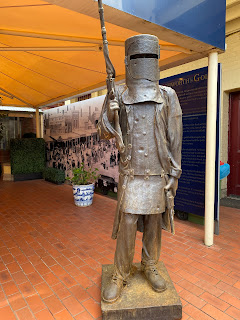While in Corowa we took some time and went to Beechworth again - and this time I did the walk along the Beechworth Gorge.
Christ Church St. Peter and St. Paul was built between 1857 and 1859, with the commanding bell tower added in 1864.
Christ Church’s old stone hall.
A beautiful place to go for a walk in Beechworth is the Gorge Walk. It has magnificent views to the Woolshed Valley, and of Spring Creek with its cascades and tranquil rock pools.
At the start of the trail, looking across the valley to one of the local wineries.
Down into the gorge is where I’m heading.
Newtown Bridge was built in 1875 to replace an earlier wooden bridge which spanned Spring Creek. At the time it was decided that this new bridge would ‘be in service for the next 200 years’ - considered then to be the best bridge in the colonies, it is still going strong today. It was built without mortar, using keystones to lock the granite blocks together. The tail race or channel, (2.4 metres deep and 410 metres long) visible below the bridge, was cut through solid granite over a two year period in the late 1860’s, enabling the area upstream to be sluiced for gold.
First glimpse out over the Woolshed Valley
Spring Creek Bridge, crossing Spring Creek
The original Methodist church in Beechworth, built in 1857, now privately owned.
You can’t come to Beechworth and not see Ned Kelly!
Beechworth’s original Town Hall was built in 1859 and is a part of Beechworth’s Historic Precinct.
The Chinese population of Beechworth grew enormously during the gold rush, from about 60 in 1855 to over four thousand in 1857. They were administered by a protectorate system. The Chinese Protector was responsible for the collection of miners’ rights and business licenses and for enforcing the rules of the protectorate. These two buildings, the Protector’s Office and (on the right) the Warden’s Office (on the left), were completed in 1860.
This building was erected in 1856 as a ‘Gold Office and Sub-Treasury’. At the peak of the gold rush, the sub-treasury was used to store up to 14,000 ounces of gold each fortnight which would be escorted to Melbourne every two weeks. In 1880 the Sub-Treasury became the Beechworth police station and it continued to operate as such until the 1990’s when a new police station was built.
The Courthouse was built in 1858. At the peak of the gold rush in the late 1850’s and early 1860’s it served seven functions: police court, mining court, court of general sessions, court of petty sessions, county court, Supreme Court and insolvency court. The building served all the judiciary purposes in the Beechworth area until the 1970’s.
The Electric Telegraph Wire snaked its way across the country to Beechworth in late 1857 and by 1858 this modern wonder of communication was housed in the Telegraph Station next to the Court House.
Originally the site of the Rocky Mountain Mining Company, an open cut sluice operation from the mid 1800’s to the early 1900’s, now Lake Sambell (in Beechworth) is a perfect place to cool off on a hot day!
The 1850’s Gold Rush saw many Chinese nationals converge on Beechworth seeking their fortune. The Beechworth Chinese Gardens were created to celebrate and honour Beechworth’s rich Chinese Heritage. Designed using Feng Shui principles, the gardens feature a series of pond, extensive plantings, and peaceful places for contemplation.




























No comments:
Post a Comment